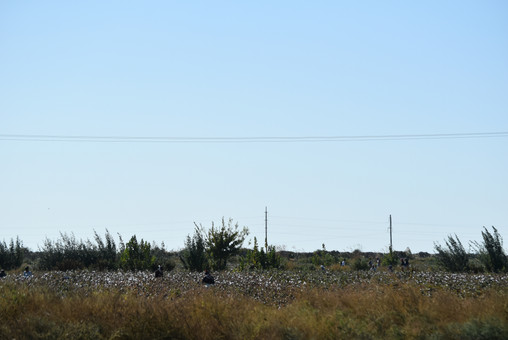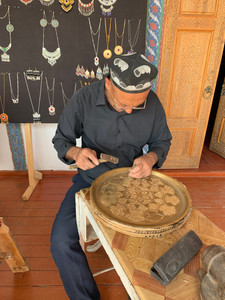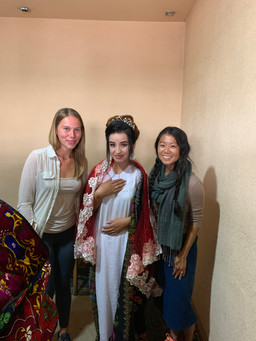Hand Over Heart: Fergana Valley, Uzbekistan
- tangio
- Nov 6, 2019
- 12 min read
One of the first things we noticed upon entering Uzbekistan is how everyone tenderly places their hand over their heart as they greet you with, “Salaam Alaykhum” (hello, or literally, “peace be upon you”). We had heard and used the verbal phrase earlier, but this additional hand gesture was unique to Uzbekistan—an old man passing by on his bike took his hand off the handlebars to place it over his heart as he rode by and smiled at us; restaurant servers face you and place their hands over their hearts before they seat you; men greeting other men at a chess game or at the mosque place one hand over their hearts as they shake hands with the other. It was surprisingly endearing to see this simple but powerful motion throughout the country, and we loved the way it made us feel when we got to return the gesture.
Welcome to Uzbekistan
This endearment and kindheartedness are not how the guidebooks and websites about Uzbekistan would have you feel; on the contrary, they had us semi-worried about crossing the border (the difficulty we experienced obtaining our e-visa online had not set us at ease either; the website is notorious for being glitchy and did not work smoothly for us). They warned us to be prepared to wait in long lines, to count out exactly how much money we had in all currencies because we’d have to report every single cent, to get rid of any medicines with codeine or pseudoephedrine in them, and to be careful about which books we brought in or which salacious photos might be on our phones, lest we be detained and seriously questioned. So, after spending an hour deleting pics off our phones (jk jk), we hopped on a 15-minute marshrukta bus ride from our hostel in Osh, Kyrgyzstan, to the nearby border with Uzbekistan.
To our pleasant surprise, the experience could not have been more different from the forewarnings. There were no lines at all—we walked right past the chain-link fence and smiling border guard, and into the passport check. The wrinkly black-and-white printouts of our e-visas were quickly accepted and the only question the guard asked us was where in the U.S. we were from. Like everyone else before him, he smiled widely when we said California. They did check our bags briefly and ask if we had drugs and books, but a quick scan of our diarrhea meds and guidebook ended that conversation. No further registrations, applications, or money reporting were required. The only reason the process took longer than five minutes was because no one was in line behind us and the friendly guards wanted to chat. They asked what we wanted to do in the country, offered suggestions, and told us how much a shared taxi should cost to Fergana so that the drivers wouldn’t rip us off. This warm introduction to Uzbekistan became emblematic of the continued Silk Road hospitality ahead.
To be fair, this process was indeed quite different and far stricter only several years ago, but since the current president took office in 2016, Uzbekistan has become more travel-friendly and open. As we would learn, this is just one of many sweeping changes and reforms that have taken place across the country as recently as 2018 and 2019, many of which we’ll touch on below. Witnessing the country on the edge of these changes was both an exciting and curious time to be there.
As expected, we were swarmed by taxi drivers as soon as we stepped out of the border crossing. After some quick gesturing and broken English, we paired up with a Belgian couple, Barbara and Nils, to share a 90-minute taxi ride from the border to Fergana. This drive through the Fergana Valley was a great teaser for the country, with the scenes outside our car window passing by like a documentary playing a reel of everyday Uzbek life for us. We were still so close to Kyrgyzstan, but already, we could see some immediate differences. First of all, the people are much more Turkic and less Asian in appearance; many locals boast the incredible mix of caramel skin with piercing light green eyes unique to these Silk Road populations.
Secondly, the Fergana Valley also featured some of the first signs of planted agriculture we had seen in a while. The drawn political lines had given Kyrgyzstan the mountains and water while Uzbekistan received the fertile lands (a division that has led to years of conflict, of course), and here, we finally saw the beginning of many grape vineyards (which did not make for good local wine, unfortunately)—and endless fields of cotton throughout the country. Uzbekistan cotton is infamous for two main reasons:
1) Irrigation for the industry has led to the near disappearance of the Aral Sea, one of the greatest water management and environmental debacles in modern history. In short, the Aral Sea, in western Uzbekistan, has been so overdrawn and desiccated for cotton irrigation that it recedes 200 meters per year, leaving behind a dry wasteland of salt flats and seabed floors that used to be thriving water ecosystems, and once-vibrant fishing villages are now located over 200 kilometers from the shores of the sea they once knew. Tourists now visit to catch a glimpse of the receding sea while they still can, as well as the beached, abandoned ships that used to be in water but are now stuck in the sand.
2) The industry has been fueled by the prior state-forced labor of children, students, and professionals, such as teachers and other governmental workers, who were required to manually harvest cotton to meet regional production quotas. This was not just a thing of unchecked policies from the past; local friends told us that even people our age and younger were required to go pick cotton while they were in college not too long ago, if they went to a state university. Fortunately, systemic forced labor and all child labor ended two years ago under the new president. Today, they are moving toward a system of private management wherein international textile companies with Uzbek factories are allocated land for cotton, with each managing their own supply chain and farmers. Of course, private management can have its problems, too, but often, these international companies are under their own country’s stricter labor standards; wages have gone up (our local friend told us that wages have quadrupled, though from a miserly low base) and new systems are being introduced, including some harvesting machinery. The U.S. actually lifted its ban on Uzbek cotton earlier this year in 2019, though many clothing brands and companies around the world continue to boycott it; the International Labor Organization continues to keep a close watch as progress is slowly being made.
In those first hours outside our taxi window, we saw agricultural scenes that would repeat itself many times over during this peak fall cotton-harvesting season: lines of middle-aged women in the fields, harvesting by hand under the blazing sun or well into sunset, carrying their day’s work with them in personal bags (they get paid by the kilogram harvested).
Finally, Fergana Valley is renowned for its deep history of master artisans in fine ceramics and silks, passed down through families and apprenticeships, which we still saw on full display today as we drove by village towns. These fine quality products were prized along the Silk Road caravans, contributing to the Silk Road moniker and making their way along the trade routes from Asia into the riches of Persia and Europe.
Fergana
The city of Fergana itself, where we spent our first two days in the country, retained this cultural artisan background while also feeling quite modern (or at least more modern than we expected, given what we had read). It did not feel conservative or agricultural, but rather, quite secular and industrial. It featured clusters of mini shared buses, busy food bazaars, and random piles of rubble on the streets alongside wide boulevards, well-dressed young people canoodling on park benches, and brand new Ladas and white Chevrolets driving around massive traffic roundabouts.
Our guest house too was a display of contrasts: it was very nicely appointed with a great modern bathroom and a spacious shared kitchen, but there were no roads leading to it and we had to walk behind a dilapidating parking lot and a pile of trash to get there. It turns out the guest house is brand new; the owner, Sadar, had another two-room property and had just expanded his business with a few more rooms because tourism had picked up tremendously across the country in the last two years. This turned out to be a common pattern among all our guesthouses throughout Uzbekistan; gone are the difficult visa processes, the hefty fees, and the onerous entry processes, which in turn, is spawning a new age of tourism and openness since 2016. One of the things we had been worried about was the government mandate to collect registration slips from each guesthouse, indicating exactly where we stayed for every single night in the country (which makes Couchsurfing or camping difficult)—this used to be something that they check when you leave the country. However, even this practice has relaxed significantly, and registration slips are only required now when you stay in the same city for longer than three days at a time.
Having spent our first day crossing the border, taking in the sights of the Fergana Valley, buying Uzbek SIM cards, and taking out over $2 million in Uzbek soms, we felt acquainted and accomplished—and super rich.
Margilan

The next day, along with our new Belgian friends, we took a day trip from Fergana to Margilan, making the 40-minute drive to visit the town’s Kumtepa Bazaar, known for selling rolls of beautiful locally-made silk, along with every other household good you might ever need (including ironing boards, Persian rugs, and spark plugs), and the Yodgorlik Silk Factory, a historic factory that takes you through the process of creating silk from mulberry bush and silk worm to hand-weaving and dying. We toured the factory, bought some requisite silk scarves, and proceeded to walk around town to explore. After a brief lunch of traditional Uzbek cuisine, we were making our way to visit the neighborhood mosque when we heard some music pumping from a random banquet hall.
Our ears hadn’t perked for more than ten seconds before a short, jovial man wearing a traditional Uzbek cap motioned us in from the hall, guiding us into front row seats at a large banquet meal and party. Before we knew it, we were in the middle of an Uzbek wedding celebration! We later learned that it was the Kelin, which is essentially a party to welcome the bride into the groom’s family, held the day after the official wedding. There was a live band and an MC announcing our arrival as Western tourists, and we received a loud round of applause from all 200-or-so attending guests. It was too late to turn back.
Karen was called up first—maybe because she was the first of the four of us to walk in, maybe because she secretly wanted to be on the dance floor anyway—but suddenly, we were the center of attention as the only ones in the middle of the dance floor, an older woman (an auntie or grandma of the groom?) teaching us how to do some traditional Uzbek dance moves, dollar-dollar [Uzbek] bills flying in the air as guests exercised the traditional practice of throwing cash at the dancers when they saw something they liked (we learned that this cash later goes to the band as tip). It was embarrassing and awesome all at once.
This was another testament to the power of Silk Road hospitality—something we came to love in Kyrgyzstan and would also come to know so well in the next three weeks in Uzbekistan. Everyone—from the jovial old man (whose name we never learned, as he didn’t speak a lick of English), to the bride, to the creepy drunk uncle and random guests—was inexplicably kind. We can’t imagine having brought in strangers like us off the street and into our own wedding, welcoming them as premiere guests, serving them expensive food, and asking them to bow down to the bride alongside close friends and family members (as they asked us to do). But as we’ve come to learn, this is just the Uzbek way. Centuries of nomadic passers-by—ever the stranger but all needing the same respite, camaraderie, and human connection on their long journey—have led to the Uzbeks’ openhearted spirit now. It didn’t matter that we didn’t know them or couldn’t speak their language; we were guests, and that meant we were welcome to dance like fools and eat abundantly alongside them.
We were so grateful to witness and be a part of these wedding traditions, but it turns out that we would see many more weddings throughout the country over the next several weeks! October is wedding season in Central Asia. Due to the amazing daily dry weather of 70 F, everyone gets married around this time; in every Uzbek city we visited, we’d see at least six bridal processions a day at famous historical sites (even on weekdays; wedding Wednesday seemed to be a thing). It was fun to witness these photo shoots and dance processions, and interesting to see the many brides acknowledge and bow down to each other when they inevitably passed each other on the streets, sometimes even waiting till one was done with a photo shoot in front of a famous minaret before the next one walked up.
Kokand
After Fergana and Margilan, we continued our journey with Barbara and Nils to Kokand, one of the few ancient independent khanates of Uzbekistan that had its own empire in the 18th-19th centuries before the Russians took over.
The four of us hired a taxi to take us there for less than $7 USD total for the two-hour drive. Our “driver” Mustafa was 25% driver and 75% DJ. His hands were seldom on the steering wheel even as we passed large trucks and faced oncoming traffic head-on at 100 km per hour; instead, he was mostly busy switching from one hit Uzbek EDM song to the next. Mustafa not only got us to Kokand safely, but even included a random stop for all of us to try Ayran at a roadside stand. Ayran is a frothy drink made from yogurt, milk, and salt. The locals each downed a huge bowl of it in one minute, while the four of us could barely manage a few sips.
Kokand is a charming historic city with few tourists and great weather. Off the main drag, its tiny backstreets wind through local neighborhoods and houses, allowing us very slim views of what we would learn are typical of Uzbek homes—tall walls with large gates, opening up to interior courtyards surrounded by individual rooms and kitchens that entire extended families occupy together. The tall walls made it hard to peer inside, though, so mostly, it just felt like walking down narrow, enclosed corridors with nothing going on, even though we knew entire vibrant lives existed on the other side of these walls.
At one point, we happened upon a local man who was very nice and wanted to talk to us in English. He motioned for us to follow him into his home, which was under construction. Eager to finally see the “inside” of one of these courtyards, we followed him in, entering a gate and indeed seeing the half-constructed building. We waved to a couple in the half-finished kitchen as well as to the construction workers, whom we assumed were this man’s family and/or workers, though they didn’t say much. As we moved on, he continued to walk with the four of us, and it quickly became quite apparent that this guy was likely very drunk. We tried to communicate with him via Google Translate, but he clearly didn’t know how it worked because he would scream, “Do you speak English?!” into the phone—the only English phrase he knew, and one not in need of translation. We tried to lose him several times, but he was quick for an old drunk guy! In fact, we’re pretty sure now that the original house we entered was not his at all and that we had just trampled into a stranger’s home (that couple did look at us kind of oddly)! After about forty minutes and employing multiple hilarious methodologies to try to lose this guy, we finally did, dipping into the quietude of the Jome Mosque and sending him back toward the direction of his “home.”
It was in Kokand where we got our first glimpses of the magnificent Islamic tilework that fill the old palaces, mosques, mausoleums, and madrassas (schools) throughout Uzbekistan. Unfortunately, few are around anymore, and many are not restored; as such, there are not so many “must-see” destinations to see in Kokand. We visited its Khan Palace, Narbutabey Madrassa, Jome Mosque, Dakhma-i-Shokhon (a “grave of kings” that included a mausoleum for the khan, as well as visually astounding cemeteries that stretched on for blocks). Looking back, it was fitting that we visited just one of each of these building types and institutions in our first historic Uzbek city, taking the time to learn about the typical components of each, such as the layout of the student dorms and prayer rooms in a madrassa, the coronation and reception hall in a palace, or the intricate patterns of the tilework in the mosques. Because over the next three weeks, we would visit so many ancient mosques, mausoleums, and madrassas that it was helpful to have the initial templates from Kokand!
Finally, it was also in Kokand where we’d receive our first food bug of the trip! No, it was not the kilogram of plov we ordered (which lasted more than two meals and which the restaurant held for us and heated up for us the next day, no extra charge!). It must have been something from the nice last lunch with our new Belgian friends, because after we parted ways, we’ve kept in touch—and learned that all four of us got sick the next day at almost the exact same time with the exact same symptoms. Let’s just say it was a touch-and-go train ride from Kokand to Tashkent the next day, and our first 36 hours spent in the country’s capital were spent in bed.
Since we did not actually get sick until we hit Tashkent, though, we will not remember Fergana Valley for its food poisoning, but rather, for the way it taught us about and eased us into Uzbekistan with a little bit of everything we were about to experience with much more intensity in the rest of the country. More importantly, it showed us what an extraordinary and unique time it was to be there during this period of opening-up and modernization.
With a hand over our hearts, we were ready for the grand historic cities of Samarkand, Bukhara, and Khiva ahead.
Karen & Michael
Fergana Valley, Uzbekistan, October 5-9, 2019













































































Comments